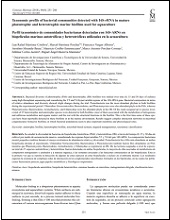Taxonomic profile of bacterial communities detected with 16S-rRNA in mature phototrophic and heterotrophic marine biofilms used for aquaculture
Perfil taxonómico de comunidades bacterianas detectadas con 16S-ARNr en biopelículas marinas autotróficas y heterotróficas utilizadas en la acuacultura
Autor
Luis Rafael Martínez Córdova
Marcel Martínez Porchas
ARMANDO FRANCISCO VARGAS ALBORES
ANSELMO MIRANDA BAEZA
Marco Antonio Porchas Cornejo
Edilmar Cortés Jacinto
MIGUEL ANGEL MAZORRA MANZANO
Metadatos
Mostrar el registro completo del ítemResumen
"Bacterial diversity of phototrophic (PAb) and heterotrophic (Hb) biofilms was studied over time (0, 15 and 30 days of culture) using high throughput sequencing and considering the V3 and V4 hypervariable regions of the 16S rRNA gene. Bacterial composition in terms of relative abundance and diversity showed slight changes during the trial. Proteobacteria was the most abundant phylum in both biofilms during the experimental period. Chlamidiae-Verrucomicrobia, Bacteriodetes, and Planctomycetes were also abundant phyla in the PAb, whereas Planctomycetes, Bacteriodetes, Actinobacteria, and Chlamydiae were the abundant phyla in the Hb. Of the reads assigned up to species level, a total of 27 heterotrophic and autotrophic species were detected in both biofilms, most of them associated with the metabolism of nitrogenous and sulfurous metabolites and organic matter, and the rest with the structural functions in the biofilm. This is the first time some of these species have been reportedly detected in these biofilms or in the marine environment. Results suggest complex interaction networks in microbial conglomerates formed in biofilms, in which bacterial populations seem to play important metabolic and physiological roles." "Se estudió la diversidad de bacterias de biopelículas fototróficas (PAb) y heterotróficas (Hb) a través del tiempo (0, 15 y 30 días de cultivo) por medio de secuenciación masiva, considerando las regiones hipervariables V3 y V4 del gen 16S ARNr. La composición bacteriana mostró pequeños cambios durante el ensayo en términos de abundancia relativa y diversidad. Proteobacteria fue el filo más abundante en ambas biopelículas durante el experimento. Chlamidiae-Verrucomicrobia, Bacteriodetes y Planctomycetes también fueron filos abundantes en PAb, mientras que Planctomycetes, Bacteriodetes, Actinobacteria y Chlamydiae se registraron en Hb. De las lecturas asignadas a nivel de especie, un total de 27 especies autrotróficas y heterotróficas fueron detectadas en ambas biopelículas, la mayoría de ellas asociadas al metabolismo de compuestos nitrogenados y azufrados y a materia orgánica, y las restantes asociadas a las funciones estructurales en las biopelículas. Esta es la primera vez que se reporta la detección de algunas de estas especies en estas biopelículas e incluso en el ambiente marino. Los resultados sugieren la existencia de complejas redes de interacción en los conglomerados microbianos formados en las bipelículas, en las cuales las poblaciones bacterianas parecen jugar papeles metabólicos y fisiológicos importantes."
Colecciones
Ítems relacionados
Mostrando ítems relacionados por Título, autor o materia.
-
PROMOCIÓN DEL PERIFITON PARA EL CULTIVO DE CAMARÓN BLANCO: HACIA UNA ACUICULTURA ECOLÓGICA
DOMENICO VOLTOLINA LOBINA; JUAN MANUEL AUDELO NARANJO; MARIA DEL ROSARIO PACHECO MARGES -
Suelo y Erosión
YOLANDA LOURDES MAYA DELGADO


